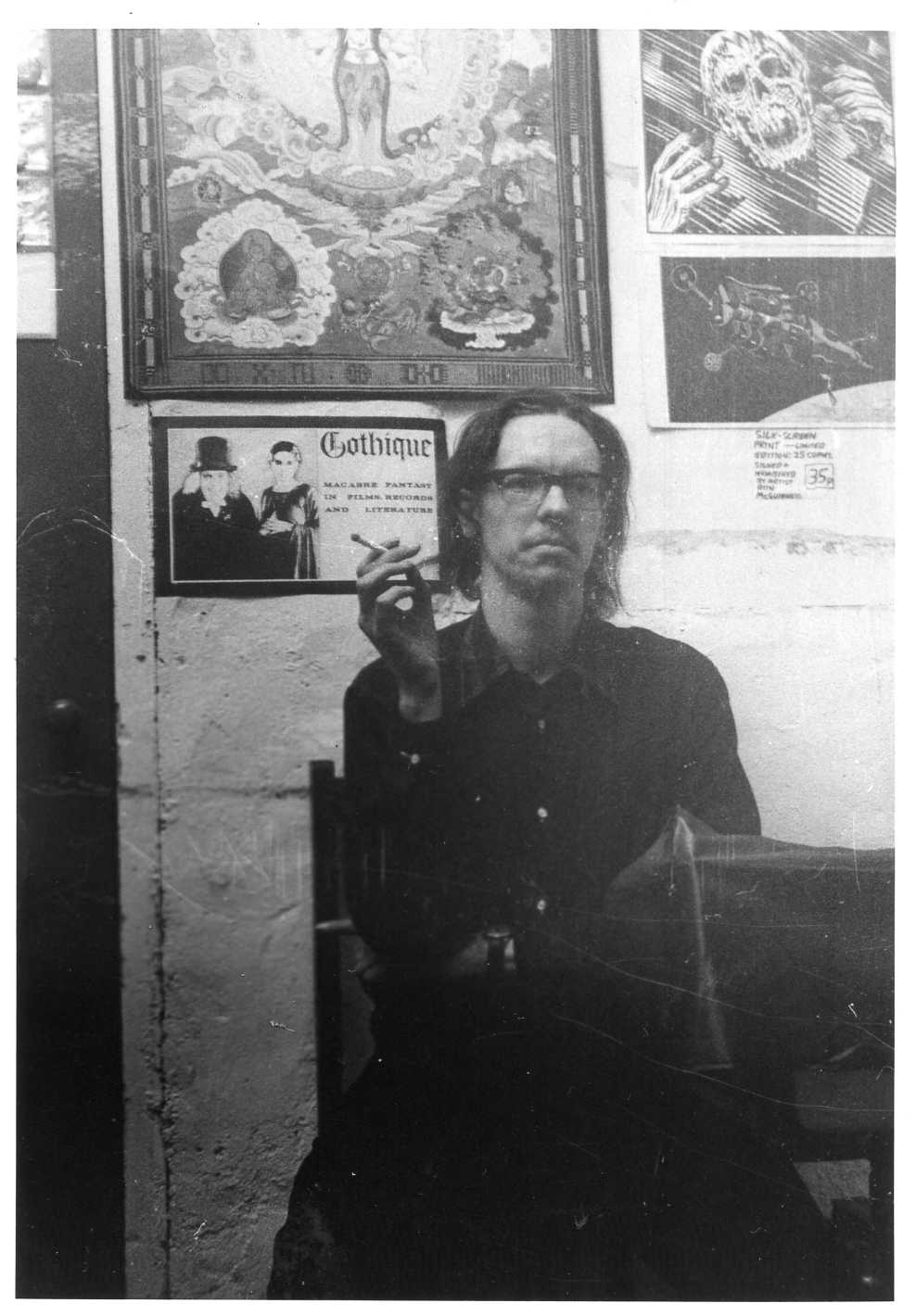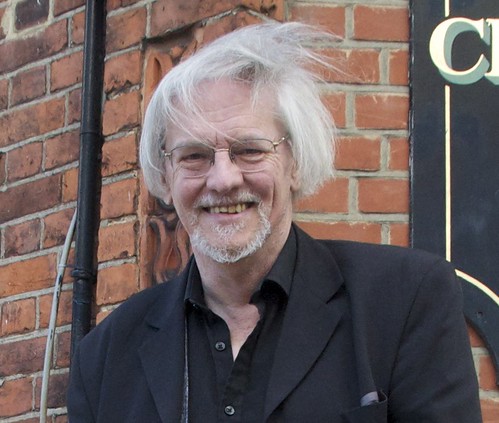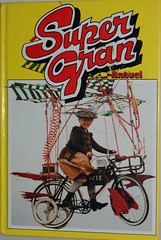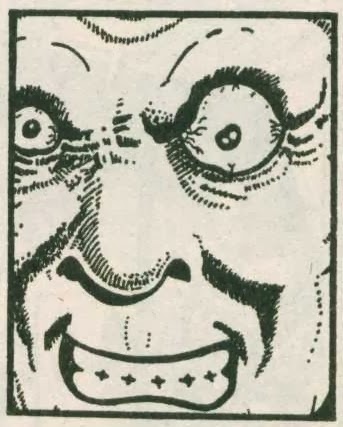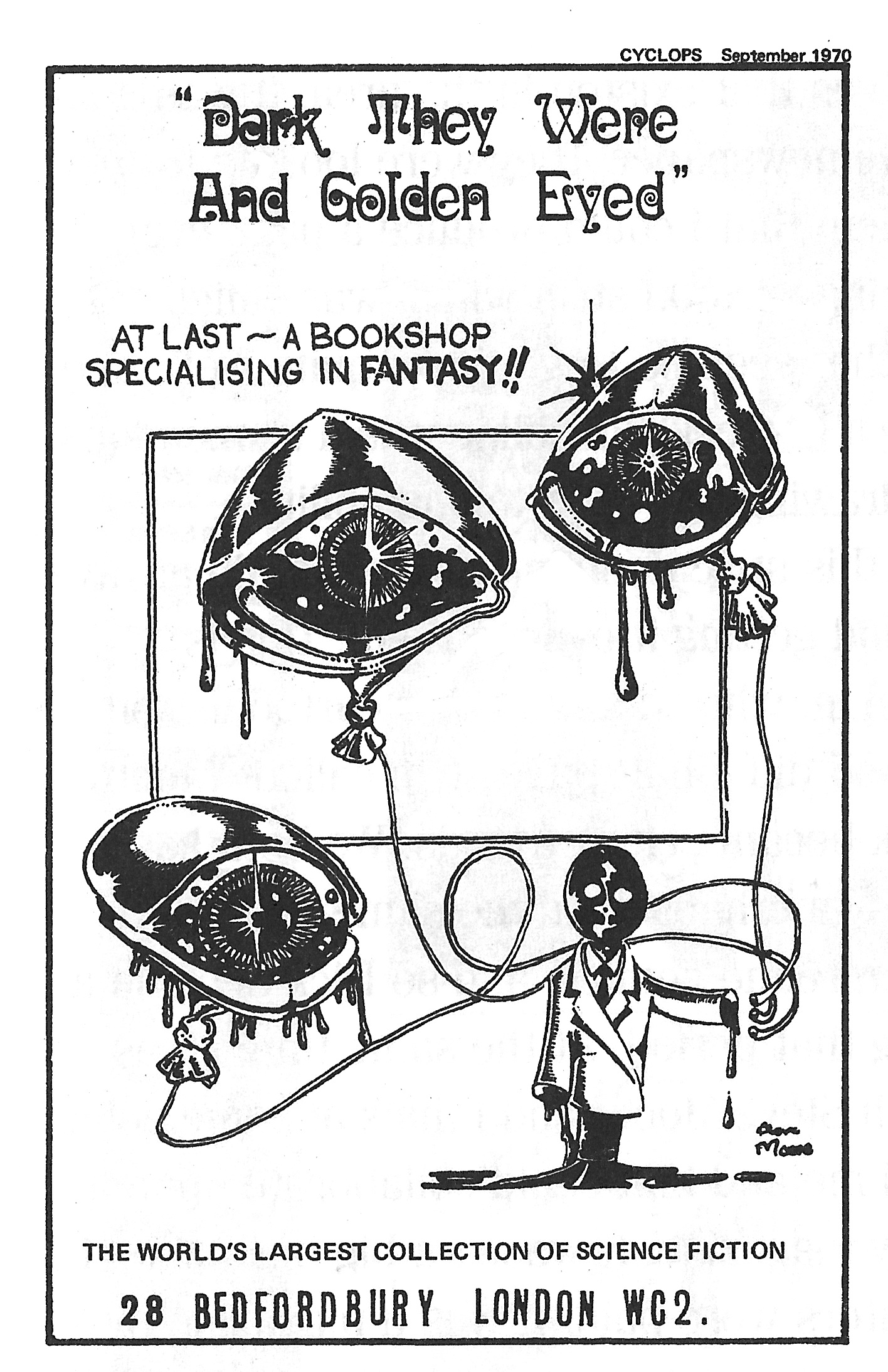Here’s the fourth part of my interview with the late Steve Moore, with more to follow. The first, second, and third parts are already online, along with some explanation of how the interview came about.
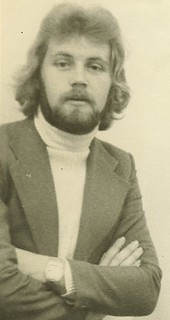
SM: It was okay at the time, though I’ve never really got on that well with men from the north of England. I’ve generally found them opinionated, pig-headed and sexist; on the other hand, I know they tend to think of us southerners as over-intellectual wimps. Both of these are completely clichéd generalisations, and I’m sure the first is no more true of all northern men than the second is of all southerners, but in my experience there seems to be a bit of a gulf in attitudes. So at Fleetway, relations with Dez were generally cordial, though occasionally a little caustic, and we weren’t actually working on the same magazine which meant we didn’t spend the whole day together. He was never someone I really wanted to actually socialise with, though. I tended to hang out with Steve Parkhouse and left all thoughts of Dez behind when I left the office.
On the other hand, my professional relationship with Dez, between writer and editor, was very close for several years and generally problem-free, and we worked together on House of Hammer, Starburst, Hulk Comic, Dr Who Weekly and, eventually, Warrior. At that point things started to go wrong, but until then he was another editor who’d accept everything I gave him with virtually no changes and we did a lot of stuff together, some of which, I like to think, was pretty good.
->PÓM: Didn’t you end up working for Dez as a freelancer, later on?
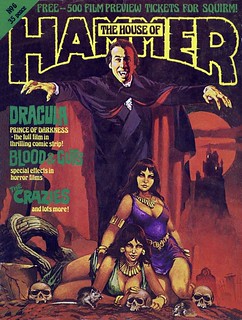
–>The first issue of HoH was dated October 1976, so I’d guess we started working on it in the summer, or maybe a bit earlier. Looking back, I see that John Barraclough and Chris Lowder were mentioned as associate editors on the early issues, so it’s the same little clique that had first got together at IPC again.<-- I wrote a number of features in the early issues, despite the fact that there were far more competent film-journalists also working for the magazine, and Dez and I also took a day-trip to Elstree when Hammer were shooting To the Devil a Daughter, which meant another feature I got to write up, in issue 2. We did actually get on the set briefly, while they were filming (I only got round to watching it recently – dreadful movie), but we spent most of the time talking to special effects man Les Bowie, who took great delight in showing us how gory effects could be got with latex skin and artificial blood. A charming man who really seemed to enjoy his work.
The articles had my name on, but they weren’t so good at crediting the comic-strips, at least early on. I did quite a number of movie adaptations, where we were generally working from copies of the original scripts, plus photos; and also some of the short stories, ‘Van Helsing’s Terror Tales’.
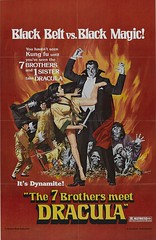
Issue 8 saw my first ‘Father Shandor, Demon Stalker’ solo story, with John Bolton artwork. Shandor had first appeared in Dracula Prince of Darkness, which we’d adapted in issue 6, though Donne Avenell wrote that (John had been the artist on that as well). I think Dez suggested the idea as a way of stretching the material, though obviously it would have been quite a while before we ran through all of Hammer’s horror films. He told me we could do the strip because, unlike in the Dracula movie where the name of the character was given in the credits as 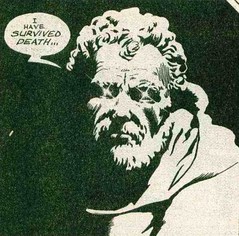
Other adaptations I did included Curse of the Werewolf (issue 10), Plague of the Zombies (13), One Million Years B.C. (14), The Reptile (19), Captain Kronos, Vampire Hunter (20, with Steve Parkhouse doing the artwork, which was nice), The Mummy (22) and Brides of Dracula (27-28). From this level of detail, you’ll gather that my copies of HoH were actually accessible! I know I did a few of the ‘Terror Tales’, but these were frequently uncredited, so it’s a bit hard for me to remember which were by me. I think I wrote three or four of those.
I’m not quite sure why the title changed from House of Hammer to House of Horror with issue 19, and then to Halls of Horror with 21, but I suspect this may have been something to do with the contract with Hammer. Effectively, the magazine folded in August 1978 with issue 23, though Dez revived it as a ‘Quality’ publication in 1982, as a companion to Warrior. By then I was no longer writing for it, though, and the Brides of Dracula adaptation was a left-over script from the original series. The magazine finally folded for the second time in 1984.
I had a fair amount of fun on HoH, as well as getting a reasonable amount of work out of it. I found script adaptation really quite easy, and we had a good bunch of artists and writers, including John Bolton, Brian Lewis, Steve Parkhouse, David Jackson and Chris Lowder, as well as some more ‘old school’ writers like Donne Avenell and Scott Goodall. And that basically set me up as one of Dez’s main writers, when he moved on to Marvel UK.<- PÓM: Did you find it easier working on your writing away from home, or did it make any difference?
SM: Frankly, this is a question I’ve never really had cause to think about before, and since 1973 I’ve pretty much done all my writing at home anyway. And when I still had family here, they always understood that I needed to work and left me alone. So, I think the first answer would be no, it wasn’t easier working away from home. But whether it was harder I’m not really sure. When you’re 23/24 and just starting out, you’re full of energy and enthusiasm, and that carries you through an awful lot … including, I suspect, having to deal with customers while you’re typing.
PÓM: Who else did you end up writing for at this time?
SM: Actually, my memory of the period around 1973/4 is a bit fuzzy. I suspect after Target folded may have been the period when I was writing for Mirabelle, and I’m not sure how long I continued writing Tarzan for Sweden. If I’d known I was going to end up doing this interview, I would have kept all those old account books!

By the following year, John Barraclough had taken over as editor of Brown, Watson’s annuals, working from offices in Wardour Street, and that started an association that went on until 1986. After a few years, the Babani brothers, Brian and Peter, bought out the annual department from Thorpe & Porter and set themselves up as Grandreams Ltd., with offices in Kentish Town, but John continued as editor, I continued as main writer, and the annuals continued to look exactly the same.
That was pretty much my winter work taken care of, over those dozen years, though obviously I’d frequently be writing for weeklies at the same time. I’d get a call from John around September, and he’d tell me what we were going to be doing that year for publication the following autumn, and I’d generally get between four and six annuals to do, which would keep me busy until the spring. Sometimes I wrote the entire book. I’d nearly always write all the strips and text stories, while sometimes I’d do the features, and sometimes someone else would. If he wanted to include things like puzzle pages, they were definitely by someone else! In the end, I wrote 69 annuals for John, in whole or in part, doing things like Kung Fu, Planet of the Apes, The Bionic Woman, The Fall Guy, Knightrider, Dick Turpin, Sherlock Holmes, The Dukes of Hazzard, Battlestar Galactica and even some dreadful old rubbish like Supergran.
Usually for each annual I’d be writing three 8-page scripts and three or four 2,500 word text stories, though sometimes I’d link things up as serials, and do the strip as, say four chapters of six pages each, or link the text stories. By now, John just trusted me to give him what he wanted, so I pretty much handled things the way I liked. I remember by the time we got to the fourth Kung Fu annual he called me and said something like: ‘We’ve got to do it again, but we haven’t got the budget to include any comic-strips this time, so you can just fill up the 64 pages with whatever you like.’ Like I said, John wasn’t exactly a control freak.
The money wasn’t all that great (I think it was about £10 a page for strips, though by the time it got to the 1980s, I told John I couldn’t afford to work for that any more, and got an immediate pay-rise to £15), but there was a lot of work there, which made up. Even so, it had to be done quickly to make it economical, so I was often doing a story a day … though a ‘day’ was actually lunchtime to lunchtime. After lunch I’d start thinking about a story, and if it was a strip I’d make sure that by the time I went to bed I’d sorted out the plot, broken it down into frames and usually scribbled out the dialogue; then in the morning I’d type up the script, mail it to John, and then after lunch, start the whole process again. If it was a text story, I’d just sort the plot out in the afternoon, then write the story the next morning, straight onto the typewriter in one draft with no revisions at all. If it looked like I had too much plot, the action would suddenly speed up toward the end; if too little, it’d slow down! But generally, after a couple of years, I’d got things sorted out, and knew pretty well how much plot I needed to write a 2,500 word story.
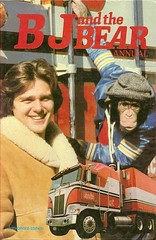
If the TV programmes were already showing, I could just watch them, or if we were doing the annuals for the second or third time, there was no problem. More often than not, though, the programmes wouldn’t start showing until after I’d written the book, so then I’d possibly be taken to a little preview theatre in Wardour Street to see an advance showing of the pilot, or sometimes the only reference I’d have to work from would be a script and some publicity photos. Fortunately, though, I seemed to have a knack for picking out the essentials of the characters and what the show was about almost instantly (and perhaps even more fortunately, I had a very easy-going editor!), so I managed to get away with it. Knightrider was one of the shows where I only saw the pilot and, as it happened, I really didn’t like the programme very much, so I couldn’t bring myself to watch it when it started on TV … but I still wrote five annuals for the show, just on the basis of the pilot.
The worst case was writing the strip adaptation of the Roger Moore James Bond movie, Octopussy, which was published as a hardback annual by Grandreams, and as a magazine in the USA by Marvel. As usual with James Bond movies, the film company were incredibly secretive, so they wouldn’t let me have any production photos, and they wouldn’t let me take the script away either. Instead I had to go into their office in central London for three or four days running and sit there alone in a private room with the script, jotting down the essentials of the plot in a notebook. And that was all I had to write the script from … but I still ended up with the film company congratulating me on the job I’d done. Paul Neary drew the strip, and I’m not sure if he got any reference either, but everyone seemed happy, so we just moved on to the next project.
So, like I said, this went on until 1986, and that autumn the phone didn’t ring, and I was busy with other stuff, so I didn’t ring either, and that was the end of it. I never heard from John again, and have no idea what happened to him, though I occasionally think it would be nice to know. But I think the TV-based annuals had pretty much passed their sell-by date by then (the previous year I’d only done one or two), so even if I’d wanted it, there probably wouldn’t have been a great deal of work to be had anyway. At some point I’ll have to read some of that stuff again, just to see if it really was any good (or otherwise) after all.
PÓM: Tell me about those movie scripts you mentioned.
SM: As I said, it came about through my knowing Roy McAree, and I’m guessing it would have been about 1976, as I’d seen a few movies scripts by then, either from adapting them for House of Hammer, which was starting up around then, or from seeing them for reference to the TV-based annuals I was writing by then. The first explosive kung fu boom was starting to blow out by then, and Roy knew what I did for a living when I wasn’t goggling at gorgeous Chinese actresses, so one day I got a call from him telling me he wanted to set up his own production company, and was looking for someone to write a script. The deal was that there’d be no money up front, but if the movie was made I’d be on a percentage and, in terms of usual movie industry rates, quite a large percentage too. As far as I recall, I think he had some sort of basic plot idea or outline, which never actually had a title. It was just referred to as ‘Snutch’, which Roy derived somehow from ‘no such’ movie, as he didn’t want to give anything away in the trade. It was intended to be a vehicle for Wang Yu, which suited me very well as he was one of my favourite Chinese actors, and was going to be set in Iran (this was obviously before the Islamic Revolution of 1979).
There are basically two types of movie script. The first is a ‘first draft’ script, which describes the action and gives the dialogue, and is what most people present when they’re trying to sell something. And then there’s the ‘shooting script’, which has all the camera directions, such as ‘pan left’ or ‘tight close up’, which is usually written much later in the development process. Roy asked me to write ‘Snutch’ as a shooting script, so I said ‘sure’ and went away and wrote it. I’d seen at least one shooting script, and in the same way as with the annuals I seem to have a facility for picking up these sort of things, so I turned it in and Roy’s partner (whose name I forget) said ‘this is great … we can just give this to some monkey and he can get on with it’ (‘some monkey’ giving you some idea of his attitude to directors) and ‘where did you learn to write scripts?’ To which I could only reply: ‘Well, I didn’t …’ They told me to get a passport and prepare to fly out to Iran to check out locations, which frankly made me a little nervous, as it wasn’t quite clear who was supposed to be going with me.
This same partner had also written a script called ‘The New Spartans’, and they then decided to go with that first, with him directing as well. They’d raised money from Germany and elsewhere, and the cast included Wang Yu, Toshiro Mifune, Harry Andrews, Britt Eklund and others of similar calibre. They got a couple of days into shooting when the Germans pulled their money out. In later years, one of my Chinese movie dealer contacts actually managed to get me a DVD of the rushes they’d shot, and frankly they were absolutely appalling, so I’m not surprised the Germans pulled the plug. But that caused the collapse of the entire enterprise, and I think Roy lost quite a lot of money. Eventually he moved to Hong Kong, where I know he produced at least one documentary about kung fu movies, and of course by then I lost contact with him. Shame. Roy was a nice man, and though I never got paid for my work, I never held it against him.
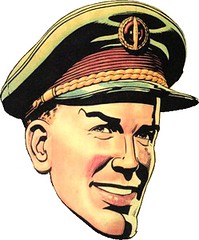
At some point in all this, though I’m not sure of the exact sequence, another of Roy’s producer friends offered me £200 to revise the script of his Mary Millington soft porn movie into something ‘good’, but I took one look at the script and told him that no one could make that sort of rubbish ‘good’, no matter how much he was paid, and didn’t take the job. And that concluded my involvement with the movie industry, with an understandably sour taste in my mouth. So, essentially, I’ve just refused to have anything to do with movies or TV ever since.
PÓM: Did you ever actually learn Chinese, or go visit the country?
SM: I didn’t learn the language in any formal way, though over the years I’ve come to recognise quite a number of phrases while watching movies, so long as they’re spoken in Mandarin (the national language) rather than Cantonese (the southern dialect they speak in Hong Kong). But I wouldn’t dare try to speak it, as the language is tonal, so words can be pronounced in any of four different tones, and you might have, say, forty different words pronounced ‘ming’, the only way you can tell which is the right one being the tone it’s pronounced in, and the context it appears in; so the possibility of asking for a pint of milk and unintentionally saying something like ‘My postilion has been struck by lightning’ is quite high. Not for nothing did someone once describe Chinese as ‘not so much a language as a disease’!
But I’ve always been more interested in reading the language than speaking it, and while I don’t remember an awful lot of characters, I can often pick my way through a short piece of text with the aid of a dictionary. Mind you, learning how to use a Chinese/English dictionary is a bit of an achievement in itself! Fortunately, there are now computerised dictionary programs that make life rather easier. Even so, sorting out a paragraph of Chinese would still take me quite a long time.
As for the second part of your question, like I said earlier, I’ve never been east of Dover. I’m really not much of a traveller and, while there are obviously historical sites it would be fascinating to see, modern China isn’t really what I’m interested in. What appeals to me is a romanticised, traditional China that no longer exists, if it ever did, because that romanticised version is largely coloured by tales of Daoist magicians and the heroics of wuxia fiction. Better to keep to the China in my head, I think, rather than be confronted by contemporary reality.
To be continued…
[Because the above section is, by my standards, quite short, to allow the next section to start where it needs to, I’m adding on a list of All Steve Moore’s Brown Watson / Grandreams Annuals in both alphabetical and chronological order. This list was sent to me by Steve himself, and he told me it was compiled with the help of Steve Holland of Bear Alley Books.]
Brown Watson/ Grandreams Annuals with Work by Steve Moore
SYMBOLS
C = Cover
F = Features
I = Illustrations
R = Reprint
S = Strips
T = Text Stories
U = Unknown
W = Whole Book
Illustrators named where known
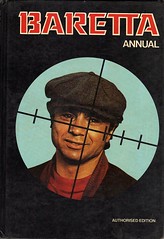
1977 – T?, S? (I must have written something for this, or I wouldn’t have a copy! But a lot of it doesn’t read like me. Maybe one T?) (I – John Bolton)
BATTLESTAR GALACTICA
1978 – T, S (F???) (John Higgins)
BIONIC WOMAN
1977 – T, S, some F (Ian Gibson)
1978 – T, S (Ian Gibson)
BJ AND THE BEAR
1981 – T, S (cartoons – Alan Moore [here])
BRING’EM BACK ALIVE
1982 – T, S
DICK TURPIN
1979 – T, S (Felix Carrion)
1980 – T, S (Felix Carrion)
DUKES OF HAZZARD
1981 – T, S
1982 – T, S (Cartoons – Alan Moore, reprinted from BJ & THE BEAR)

1981 – T, S (David Lloyd)
1982 – T, S (David Lloyd)
1983 – T, S (David Lloyd)
FANTASTIC FOUR
1979 – T, F? (S = R. I – Evi DeBono)
1980 – T (S = R. I – David Lloyd)
FLASH GORDON
1977 – F (S = R. I – John Britton)
GEMINI MAN
1977 – T, S (S, I – Ian Gibson. I – John Bolton)
GRANGE HILL
1980 – S (From synopses by Phil Redmond?) (T by David Angus, from Redmond synopses) (I – John Cooper)
HULK
1979 – T, S, F? (John Higgins + R )
1980 – T, S (David Lloyd + R )
1981 – T (S = R. C – Paul Neary, I – David Lloyd)
1982 – T (S = R. C, I – Paul Neary)
1983 – T (S = R. C, I – Paul Neary)
1984 – T (S = R. C – Paul Neary. I – U)
KARATE KID
1987 – T, S, 1F
KNIGHT RIDER
1982 – T, S (F???) (David Lloyd)
1983 – T, S (David Lloyd)
1984 – T, S (Jim Eldridge)
1985 – T, S (Jim Eldridge)
1986 – T, S (Jim Eldridge)

1974 – W (S – Desmon Walduck, I – Melvyn Powell)
1975 – W (S – U, I – John Bolton)
1976 – W (S – Paul Neary, I – Ian Gibson)
1977 – W (I – John Britton, John Bolton?)
LOGAN’S RUN
1978 – T, S (David Lloyd)
MANIMAL
1984 – T, S, 1F (John Higgins)
MASK
1986 – T (S = R )
1987 – T (S = R)
MAVERICK
1981 – T, S
MISSION GALACTICA
1980 – T, S (John Higgins)
MR MERLIN
1982 – T, S, some F (Mick Austin. 2F, I – Steve Moore)
NEW AVENGERS
1977 – 1 S, some F (John Bolton)
1978 – 2 T, 1 F (John Bolton + U )
OCTOPUSSY (James Bond movie adaptation)
1983 – S (Paul Neary)
PLANET OF THE APES
1975 – T, S , F (S = U. I – John Bolton)
1976 – T, S (S = John Bolton + Oliver Frey. I = John Bolton + U )
1977 – T, S (John Bolton)
THE QUEST
1977 – T?, S? (I must have written something for this, or I wouldn’t have a copy! But a lot of it doesn’t read like me.) (I – Edmond Ripoll)
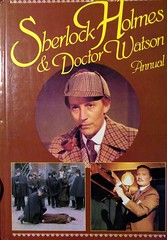
1979 – T, S (Carlos Cruz)
SPIDER-MAN
1979 – T, F? (S = R. I – Evi DeBono)
1980 – T (S = R. I – David Lloyd)
1981 – T (S = R. C – Paul Neary. I – David Lloyd)
1982 – T (S = R. C – Paul Neary. I – Paul Neary + Mick Austin)
1983 – T (S = R. C, I – Paul Neary)
1984 – T (S = R. C, I – U )
1985 – T (S = R. C, I – U )
SPIDER-WOMAN
1983 – T (S = R. I – Leigh Baulch + Jerry Paris?)
STAR TREK – THE MOTION PICTURE
1979 – F (S = R)
STAR WARS
1978 – F (S = R)
SUPERHEROES (Marvel)
1978 – F (S = R)
SUPERMAN & BATMAN
1976 – T (S = R. I – John Bolton)
1977 – T (S = R. I – John Britton, John Bolton)
T.J. HOOKER
1983 – T, S (John Higgins)
TALES OF THE GOLD MONKEY
1982 – T, S (David Jackson)
TARZAN
1976 – T (S = R. I – John Bolton)
1977 – T (S = R. I – John Bolton)
THUNDERBIRDS 2086
1983 – T, S (John Higgins)
YOUNG MAVERICK
1979 – T, S
1974 (1)
KUNG FU

KUNG FU
PLANET OF THE APES
1976 (4)
KUNG FU
PLANET OF THE APES
SUPERMAN & BATMAN
TARZAN
1977 (10)
BARETTA
BIONIC WOMAN
FLASH GORDON
GEMINI MAN
KUNG FU
NEW AVENGERS
PLANET OF THE APES
The QUEST
SUPERMAN & BATMAN
TARZAN
1978 (6)
BATTLESTAR GALACTICA

LOGAN’S RUN
NEW AVENGERS
STAR WARS
SUPERHEROES
1979 (7)
DICK TURPIN
FANTASTIC FOUR
HULK
SHERLOCK HOMES & DR WATSON
SPIDER-MAN
STAR TREK – THE MOTION PICTURE
YOUNG MAVERICK
1980 (6)
DICK TURPIN
FANTASTIC FOUR
GRANGE HILL
HULK
MISSION GALACTICA
SPIDER-MAN
1981 (6)
BJ AND THE BEAR
DUKES OF HAZZARD
FALL GUY
HULK
MAVERICK
SPIDER-MAN
1982 (8)
BRING’EM BACK ALIVE
DUKES OF HAZZARD
FALL GUY
HULK
KNIGHT RIDER
MR MERLIN
SPIDER-MAN

1983 (8)
FALL GUY
HULK
KNIGHT RIDER
OCTOPUSSY
SPIDER-MAN
SPIDER-WOMAN
T.J. HOOKER
THUNDERBIRDS 2086
1984 (4)
HULK
KNIGHT RIDER
MANIMAL
SPIDER-MAN
1985 (3)
KNIGHT RIDER
SPIDER-MAN
SUPER GRAN
1986 (2)
KNIGHT RIDER
MASK
1987 (2)
KARATE KID
MASK


